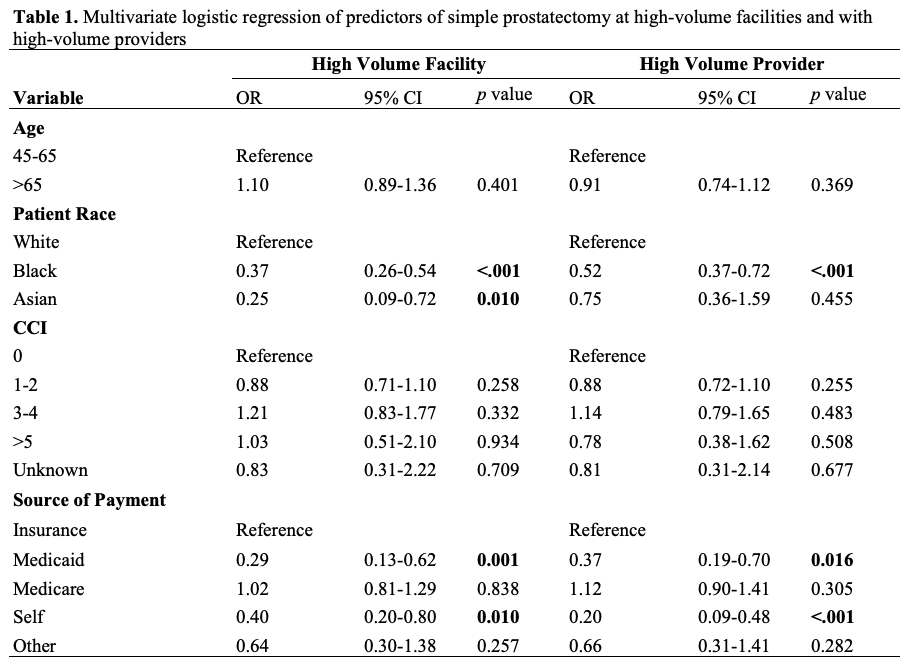Back
Poster, Podium & Video Sessions
Podium
PD39: Benign Prostatic Hyperplasia: Epidemiology, Evaluation & Medical Non-surgical Therapy
PD39-10: Sociodemographic disparities in access to high-volume providers and facilities for simple prostatectomy: A New York Statewide analysis
Sunday, May 15, 2022
8:30 AM – 8:40 AM
Location: Room 243
Krishna Ravivarapu*, Olamide Omidele, Evan Garden, Chih Peng Chin, Micah Levy, Alexander Small, Joseph Sewell Araya, Michael Palese, New York, NY
- KR
Krishna Teja Ravivarapu, BA
Medical Student
Icahn School of Medicine at Mount Sinai
Podium Presenter(s)
Introduction: Prior studies have demonstrated that patients receiving care from high-volume centers and surgeons are afforded superior postoperative outcomes. Here, we aim to assess potential sociodemographic disparities in access to high-volume surgeons and hospitals for simple prostatectomy (SP) in New York State. Furthermore, we aim to identify predictors of access to high-volume care.
Methods: Using the New York Statewide Planning and Research Cooperative database (SPARCS), we analyzed SP cases from 2009 to 2017. Cases were sorted into low-, medium-, and high-volume facility and provider volume by percentile. Patient, provider, and facility level factors were compared across volume groups. Multivariate analysis controlling for patient-level factors was conducted to identify predictors of access to high-volume surgeons and hospitals.
Results: We identified 2,008 SP cases. Low-volume providers were more likely to have less than 15 years of experience compared to high-volume providers (34% vs. 11%, p<0.001). Low-volume providers were also less likely to use a robotic approach compared to high-volume providers (9% vs. 12%, p=0.038). A greater proportion of low-volume facilities were rural (6% vs 0%, p<0.001) and non-teaching (17% vs. 13%, p=0.001) compared to high-volume facilities. A greater proportion of Black patients received care with low-volume providers (18% vs. 8%, p<0.001) and facilities (20% vs. 6%, p<0.001) compared to high-volume groups. A greater proportion of Medicaid patients were associated with low-volume providers (6% vs. 2%, p<0.001) and facilities (8% vs. 1%, p<0.001) compared to high-volume groups. On multivariate analysis, negative predictors of receiving care from high-volume facilities included Black race, Asian race, Medicaid status, and uninsured status (all p<0.05). Negative predictors of access to high-volume providers included Black race, Medicaid status, and uninsured status (all p<0.05).
Conclusions: Sociodemographic disparities exist for access to high-volume care for SP patients in New York State.
Source of Funding: None.

Methods: Using the New York Statewide Planning and Research Cooperative database (SPARCS), we analyzed SP cases from 2009 to 2017. Cases were sorted into low-, medium-, and high-volume facility and provider volume by percentile. Patient, provider, and facility level factors were compared across volume groups. Multivariate analysis controlling for patient-level factors was conducted to identify predictors of access to high-volume surgeons and hospitals.
Results: We identified 2,008 SP cases. Low-volume providers were more likely to have less than 15 years of experience compared to high-volume providers (34% vs. 11%, p<0.001). Low-volume providers were also less likely to use a robotic approach compared to high-volume providers (9% vs. 12%, p=0.038). A greater proportion of low-volume facilities were rural (6% vs 0%, p<0.001) and non-teaching (17% vs. 13%, p=0.001) compared to high-volume facilities. A greater proportion of Black patients received care with low-volume providers (18% vs. 8%, p<0.001) and facilities (20% vs. 6%, p<0.001) compared to high-volume groups. A greater proportion of Medicaid patients were associated with low-volume providers (6% vs. 2%, p<0.001) and facilities (8% vs. 1%, p<0.001) compared to high-volume groups. On multivariate analysis, negative predictors of receiving care from high-volume facilities included Black race, Asian race, Medicaid status, and uninsured status (all p<0.05). Negative predictors of access to high-volume providers included Black race, Medicaid status, and uninsured status (all p<0.05).
Conclusions: Sociodemographic disparities exist for access to high-volume care for SP patients in New York State.
Source of Funding: None.


.jpg)
.jpg)